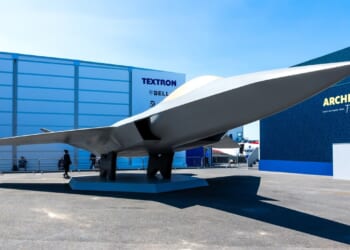It is unlikely that, as many Russian sources brag, the F-35B was a direct rip-off of the Yak-141. However, there are many staggering similarities between the two planes.
Most military and aviation buffs likely would not believe that the F-35 Lightning II, America’s premier fifth-generation multirole warplane, was really a knockoff of an old Soviet Air Force concept design.
Yet a viral video is making the rounds on social media—depicting a Soviet Yakovlev Yak-141 prototype floating above the deck of what appears to be the Admiral Kuznetsov aircraft carrier in the early 1980s, testing its vertical takeoff and landing (VTOL). It moves in the same way—and even has many similar mechanical operations—to the F-35B VTOL variant. When video of the Yak-141 and the F-35B performing separate VTOL landings are put side by side, the two aircraft look virtually identical.
Is There a Connection Between the Yak-141 and the F-35?
As defense writer Peter Suciu noted last year, Lockheed Martin did enter a partnership with the Yakolev Design Bureau (the maker of the Yak-141) in the 1990s, although Suciu posited that this “connection [was] more likely coincidental than foundational.” However, other sources claim that Lockheed’s deal with Yakolev involved funding the furthering of VTOL development in exchange for Lockheed gaining unprecedented access to Yakolev’s data on the VTOL system. Whatever the truth, superficially and in some key technical respects, the F-35B shares a very serious similarity to the Yak-141 that is too hard to ignore.
The Specifications of the Yak-141 and the F-35B
| Plane | F-35B | Yak-141 |
| Year introduced | 2015 | Never (first flight 1987) |
| Number built | Approx. 200 | 4 (prototypes) |
| Length | 51.2 ft (15.6 m) | 18.36 m (60 ft 3 in) |
| Wingspan | 35 ft (10.7 m) | 10.105 m (33 ft 2 in) |
| Maximum takeoff weight | 60,000 lb class (27,216 kg) | 19,500 kg (42,990 lb) |
| Engines | F135-PW-600 turbofan | Tumansky R-79V-300 turbofan, supplemented by 2 Rybinsk (RKBM) RD-41 turbojets |
| Top speed | Mach 1.6 (~1,200 mph) | Mach 1.5 (~1,100 mph) |
| Range | >900 nautical miles (1,667 km) | 2,100 km (1,300 mi) |
| Service Ceiling | Approx. 50,000 ft | Approx. 50,000 ft |
| Aircrew | 1 | 1 |
Sources: Lockheed Martin; Yakovlev Design Bureau.
Differences Between the Yak-141 and the F-35B
Obviously, there are real differences between the Yak-141, having been developed decades ago for a fallen empire, and the F-35B. Yet, much like the Yak-141s of the Soviet Union, America’s F-35s are not performing as magnificently as their proponents said they would. The last year that the F-35 full mission capable (FMC) data was made publicly available—2021—the F-35B had a readiness rating of only 19.5 percent. The simpler F-35A had a higher readiness rating, of roughly 50 percent. Conversely, the carrier-capable F-35C was at 9 percent!
It is unknown how these rates have changed in the half-decade since. Following the disastrous 2021 numbers, all future FMC data on the F-35 program was classified.
History of the Soviet Yak-141 VTOL Fighter
Much like the F-35, the Yak-141 had a handful of technically impressive features. Yet the aircraft was ultimately a failure in its own right. That’s why, despite the Russians having reused many Soviet-era fighters today, the Yak-141 is nowhere to be seen.
The Yak-141 (or just Yak-41) had an innovative design, featuring a high-wing monoplane design with folding wings for carrier storage, a tricycle landing gear, and a pressurized cockpit with an automatic ejection seat (Zvezda K-36LV) that activated during low-speed VTOL maneuvers. It was powered by a single Soyuz/Tumansky R-79V-300 afterburning turbofan engine, providing 108 kN dry thrust and 152 kN with afterburner. Its VTOL abilities came from a vectoring nozzle that could rotate 95 degrees downward; two Rybinsk RD-41 lift turbojets mounted behind the cockpit and canted at 85 degrees supplemented the nozzle.
The plane’s avionics included a multimode radar capable of tracking 10 targets simultaneously, with plans for a digital flight control system and helmet-mounted sight in production models—though these plans were not added to the prototype designs and were scrapped along with full production for the aircraft.
The Yak-141 was heavily armed. It was equipped with a 30mm GSh-30-1 cannon and up to 2,600 kg of external stores on five hardpoints, including air-to-air missiles like the R-27, R73, and R-60, along with air-to-surface missiles, bombs, and rocket pods. The plane was nimble in the air, too; it could reach maximum speeds of up to Mach 1.7, and a range of 1,300 miles with internal range. According to Yakolev designers, the plane’s maneuverability rivaled that of more conventional fighters like the MiG-29, though it was limited by VTOL constraints.
Unlike the F-35B, the Yak-141 had no real operational history before the collapse of the USSR in 1991. Today, there are unconfirmed reports that Russia is reviving elements of the Yak-141 design for their sixth-generation VTOL fighter program, but the truth of these rumors is likely known only to a handful in the Kremlin. However, there is reason for doubt; given that the Yak-141 was designed in the 1980s for the Soviet Navy’s then-budding aircraft carrier program, and the Russian Navy today has officially abandoned its sole aircraft carrier, it seems questionable that any updated Yak-141 as a potential sixth-generation warplane would come to fruition.
The Yak-141 and the F-35B Have the Same Mission Set
Decades after the Yak-141 was scrapped, the F-35B operates today as a short takeoff and vertical landing (STOVL) capable warbird that serves as the world’s first supersonic STOVL stealth aircraft—optimized for operations from amphibious assault ships, short runways, and austere bases. It primarily serves the US Marine Corps, as well as the air forces of the United Kingdom, Italy, and Japan.
Designed to replace the Marine Corps’ beloved but aging AV-8B Harrier, F-16, F/A-18, the F-35B was seen as the perfect answer for a Marine Corps that yearned for a more reliable vertical takeoff and landing capable bird but possessed the attack capabilities of the F-16 and F/A-18s. The F-35B shares the base F-35’s core design: a single-seat, single-engine monoplane with a trapezoidal wing, diverterless supersonic inlets (DSI) for reduced radar signature, and extensive use of composite materials—including bismaleimide and carbon nanotube-reinforced epoxy for stealth and durability. These innovations essentially make the F-35B an astonishing 35 percent lighter.
A Rolls-Royce LiftSystem, comprising a lift fan behind the cockpit, two roll posts under the wings, and a three-bearing swivel module for the engine nozzle, enabling vectoring up to 95 degrees downward is its distinguishing feature. This allows the F-35B to achieve STOVL without the fuel inefficiency of direct lift jets.
Interestingly, the F-35B lacks an internal cannon, but uses an external pod instead and sacrifices about one-third of the F-35A’s internal fuel for the lift fan. Avionics include the AN/APG-81 AESA radar, Electro-Optical Targeting System (EOTS), and Distributed Aperture System (DAS) for 360-degree awareness. With its single Pratt & Whitney F135-PW-600 afterburning turbofan engine, along with the aforementioned Rolls-Royce LiftSystem, the F-35B achieves a maximum speed of Mach 1.6 at altitude, with a combat radius of 505 nautical miles.
An F-35B features two internal weapons bays for stealth missions, carrying up to 6,000 pounds of ordnance. Six external pylons allow up to 15,000 pounds total payload for non-stealth roles, with integration for advanced weapons like the Joint Strike Missile and Storm Shadow.
The bottom line? It is unlikely that, as many Russian sources brag, the F-35B was a direct rip-off of the Yak-141. However, there are many staggering similarities between the two planes. And, yes, Lockheed Martin did fund Yakolev’s research into VTOL capabilities and had unprecedented access to the data collected—which was undoubtedly folded into Lockheed’s R&D into what became the F-35 warplane. It should come as little surprise that the two aircraft came to resemble one another.
About the Author: Brandon J. Weichert
Brandon J. Weichert, a Senior National Security Editor at The National Interest as well as a contributor at Popular Mechanics, who consults regularly with various government institutions and private organizations on geopolitical issues. Weichert’s writings have appeared in multiple publications, including the Washington Times, National Review, The American Spectator, MSN, the Asia Times, and countless others. His books include Winning Space: How America Remains a Superpower, Biohacked: China’s Race to Control Life, and The Shadow War: Iran’s Quest for Supremacy. His newest book, A Disaster of Our Own Making: How the West Lost Ukraine is available for purchase wherever books are sold. He can be followed via Twitter @WeTheBrandon.
Image: Shutterstock / rikinik.


















